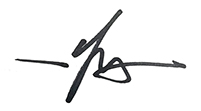Rigor × Candor
These maxim's (in no particular order) are reflective of my values and meant to be a work in progress forever. I refer to the actor as Design, because I believe the size of a design collective is irrelevant to it's values, and can still manifest in the individual practitioner (myself).

1. Exhaustive exploration
It is the designer's responsibility to consider the possibilities. Good design ideas come from everyone, and inspiration can come from anything. It's important to give every spark of an idea it's moment of attention. An idea starts out as a fragile and disintegrates easily. Nurtured (even a little bit) it grows tactile enough to be elaborated upon. The designer should keep an open mind and explore all possible problems and associated potential solutions, then cull explorations based on a rubric that outlines what success looks like. The byproduct is a fully intentional solution.
2. Domain knowledge
Design competency doesn't displace industry knowledge; it amplifies it. The effectiveness of Design is only limited by it's own understanding of it's medium. If Design is the instrument, and Enterprise the medium; then the domain (or market vertical) is the paint on the palette.
3. People>Pixels
Practically speaking, Design process revolves around users humans people. It starts with its customers, and sincerely considers its thought partners (who are people too). Without the people, the pixels never come together in a meaningful way. I say people as opposed to humans, because the latter makes it tempting to turn humanity into an ambiguous entity that can be served through generic solutions.
4. Innovation starts with a POV
A point-of-view is established when you have a vision. Its refined when you compare visions. Ultimately a vision is built with cross-discipline collaborators to refine an organizations positioning. It's how you intentionally steer the ship. Design is a catalyst for an enterprise's POV, when it does so effectively it: 1. It brings an enterprises existing vision to life, and 2. it challenges and continually refines it. You need both. Just 1 makes Design a production service, and with just 2 you won’t ship anything due to lack of partnership from cross-discipline partners and executive leadership.
5. Design considers tomorrow
It champions an enterprise's vision, or in lack-thereof seeks it. Design doesn't wait for an organizations leadership structure to provide a mission, it uncovers and articulates an existing point-of-view then challenges it's intentionality.
6. Be quick, but don't hurry
Ever since I heard Zig Ziglar say it, I hear this quote when in the trenches of a "go fast" project. Hurrying means compromising thought exercise, while being quick means emphasizing efficiency. Tactically speaking, it means working at the fidelity of an idea. It means leveraging existing learnings in the absence of new ones. Hurrying means being accepting mediocrity, leaning on the available crutch that is time constraint. If you do mediocre work when you have no time, you'll also do mediocre work when you have all the time in the world.
7. Design demands candor and integrity
Design demands every fiber of honesty an organization can muster. It requires personal, team and organization reflection. It requires that everyone leverage their individual and collective strengths, as well as be aware of and intentionally plan around weaknesses. This doesn't mean being nice, it means recognizing when someone needs help, and sacrificing yourself for them.
8. Design means leadership
The very exercise of design demonstrates a form of leadership, as it's function explores enterprise change. Good design however can only happen when that leadership transends practice of craft, and evolves into influence. That influence doesn't simply come from charisma however, it comes from the components (the people) caring for the whole (the collective). Practically speaking, it also doesn't mean people simply being nice to one another, it means willingness to sacrifice comfort to generate enterprise momentum. A designer builds up others.
9. Design generates momentum
A tangible and often overlooked byproduct of design, is the delivered perception of progress within an organization. The sharing of an idea by the designer, opens the minds of many- including their peers (which then further compound this effect). Just by demonstrating the possibility of change, Design creates optimism. With optimism, a team is able to better absorb today's mundane for tomorrow's extraordinary.
10. Design is a support structure
Design humbly recognizes it is a single pillar in a larger construct. Without paper, a designed poster doesn't meet a wall. Without engineering pixels don't work. Without executive leadership, design doesn't have healthy constraints to build within. Design recognizes it's role, and is happy to serve an organization in it's designated capacity.
11. Design genius is overrated
A single designer in a locked room and no external signals can do a lot. However they can do a lot more by absorbing the input of others, and by absorbing outside world inspiration. Design doesn't rush to steal like an artist, but uses inspiration as its own palette. Design leverages multiple perspectives to break down the old to its truths, then rebuilds them using sparks of inspiration and constraints as building materials.
12. Design is competition
If a competition is an encounter between individuals or groups carried on for amusement, exercise, or in pursuit of a prize- Design fits that definition. The very act of design competes with its control. Individual designers compete with each other, mostly for amusement, to out-think one another. Embracing this competition ironically generates comradery, and enables productive criticism. The absence of competition leads to collective mediocrity.
13. Design confidence comes from conviction
Conviction is the deliverable of a successful discovery design process phase. True confidence in a solution comes from exhaustive exhaustive exploration based on due diligence from a successful discovery exercise. Confidence in presentation is a clear indicator of quality of discovery phase, because Design cannot lie to itself that it's confident in what I'm selling (when it's not).
